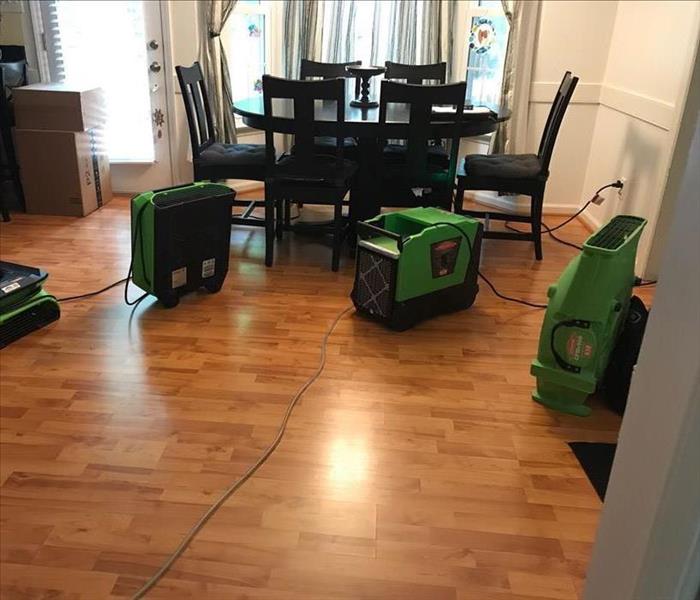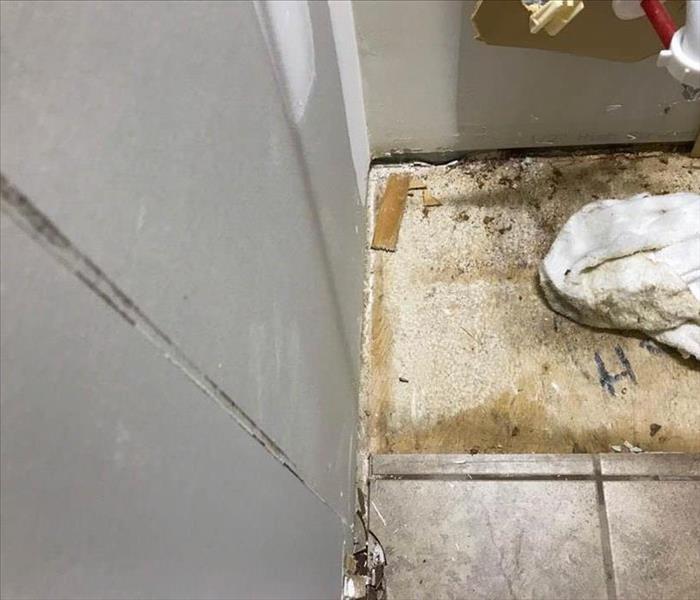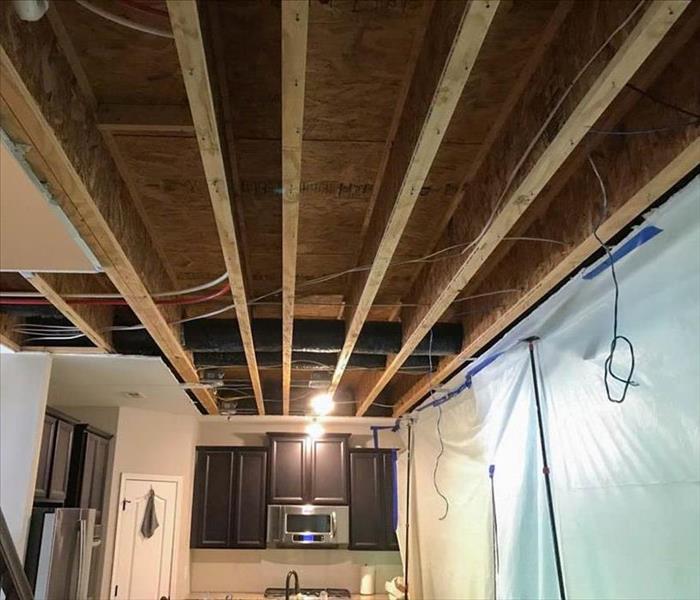Recent Storm Damage Posts
Preparing Your Property for Storm Season - Tips from SERVPRO®
1/17/2024 (Permalink)
 Our highly trained professionals are available 24/7 to assist with storm cleanup, water extraction, and restoration to help you get back on track.
Our highly trained professionals are available 24/7 to assist with storm cleanup, water extraction, and restoration to help you get back on track.
As storm season approaches in North Carolina, it's crucial to take proactive steps to protect your property against potential damage. At SERVPRO®, we understand the significance of preparing for the unpredictable nature of storms that can bring heavy rains, high winds, and even flooding. To help you prepare and protect your property and minimize storm-related damage, here are some essential tips to consider:
Inspect and Maintain Your Roof
Your roof is your property's first line of defense against storms. Conduct regular inspections to identify any loose or damaged shingles, leaks, or weakened areas. Addressing these issues promptly can prevent water intrusion during heavy rainfall.
Clear Gutters and Downspouts
Ensure that gutters and downspouts are clear of debris, such as leaves, branches, and dirt. Clogged gutters can lead to water backup, causing damage to your roof, siding, and foundation.
Trim Trees and Branches
Trim overhanging branches and trees near your property. Strong winds during storms can cause branches to break and damage your home or nearby structures. Pruning helps minimize the risk of such incidents.
Secure Outdoor Items
Secure or store outdoor furniture, garden tools, and other loose items. High winds can turn these items into projectiles, causing damage to your property or neighboring structures.
Seal Windows and Doors
Ensure that windows and doors are properly sealed to prevent water infiltration. Consider installing storm shutters or reinforcing entry points to protect against strong winds.
Backup Power Source
Consider investing in a generator to maintain power during outages. A backup power source can keep essential appliances running and help prevent further damage in case of prolonged power loss.
Create an Emergency Kit
Assemble an emergency kit that includes essentials such as water, non-perishable food items, flashlights, batteries, first-aid supplies, and important documents. Be prepared for potential evacuations or extended power outages.
Know Your Insurance Coverage
Review your insurance policy to understand your coverage for storm-related damages. Consider any necessary adjustments or additional coverage to ensure adequate protection.
Partner with SERVPRO®
In the unfortunate event of storm damage, rely on SERVPRO®'s expertise and resources. Our highly trained professionals are available 24/7 to assist with storm cleanup, water extraction, and restoration to help you get back on track quickly.
Remember, early preparation is key to mitigating storm-related risks. By taking these proactive measures, you can better protect your North Carolina property and your loved ones during storm season. For professional assistance and guidance in storm damage restoration, contact our SERVPRO® team today. Our team is committed to helping you restore your property "Like it never even happened."
Stay safe and prepared this storm season!
Coping with Property Damage After Hailstorms: A Guide to Restoration
9/25/2023 (Permalink)
Hailstorms can cause significant damage to a property, leaving behind a trail of destruction and loss. The Southeast is prone to hailstorms, especially during spring and summer. Hailstones can range in size from pea-sized to as large as a grapefruit and can cause serious damage to roofs, windows, siding, and vehicles. Coping with property damage after a hailstorm can be overwhelming, but with proper guidance, you can restore your property to its pre-damage condition. In this blog post, we'll provide tips on coping with property damage after Southeast hailstorms and guide you through the restoration process.
Safety First
Safety should be your top priority after a hailstorm. Hailstones can cause injury, and it's important to take precautions when moving around the property. Check for any hazards like downed electrical wires or broken glass before venturing out. Wear sturdy shoes and gloves to protect yourself from broken or sharp debris. If you're not sure if the property is safe, stay indoors until a professional has conducted a thorough assessment.
Document and Assess
Documenting the damage is crucial for insurance purposes and restoration planning. Take photos or videos of the damage to the property, including any damaged structures, vehicles, or personal belongings. Note the time and date of the storm and keep any receipts or bills associated with repairs or restoration. Contact your insurance provider as soon as possible to report the damage and initiate a claim.
Assessing the damage is a critical step in the restoration process. Hire a professional to conduct a detailed examination of the property to identify the extent of the damage. They will look for damage to the roof, siding, windows, gutters, and other structures. Based on their assessment, they will develop a plan for repairs and provide an estimate for the cost of restoration.
Hire a Professional Restoration Contractor
A professional restoration contractor is essential for restoring your property to its pre-damage condition. It's important to hire a reputable contractor with experience in hailstorm damage restoration. They will help you navigate the insurance claims process and perform the necessary repairs or replacement of any damaged structures or components. Be sure to obtain multiple quotes and check references before selecting a contractor.
Restoration after a hailstorm can be a lengthy process, and it's important to be patient throughout the process. Understand that your property may not be restored overnight, and there may be delays due to materials availability or other factors. Keep in frequent communication with your restoration contractor and insurance provider for updates on the progress of the restoration.
Coping with property damage after a hailstorm can be overwhelming, but with the proper guidance, you can restore your property to its pre-damage condition. Prioritize safety, document the damage, assess the damage, hire a professional restoration contractor, and be patient throughout the restoration process. With these tips, you can restore your property and move forward from the damage caused by the hailstorm.
What to Do After Hurricane Damage: Essential Steps for a Swift Recovery
6/21/2023 (Permalink)
 If your home experiences water damage from a hurricane, here are a few steps on what to do next.
If your home experiences water damage from a hurricane, here are a few steps on what to do next.
Recovering from the aftermath of a hurricane can be a daunting task, but taking immediate action is crucial for minimizing further damage and ensuring a swift recovery. In this blog, we will guide you through the essential steps to take after hurricane damage, providing valuable insights and tips to help you navigate the recovery process effectively.
Ensure Safety First
Before anything else, prioritize your safety and the safety of your family members. Assess the structural integrity of your home and be cautious of potential hazards such as downed power lines, gas leaks, or unstable structures. If you encounter any immediate threats, evacuate the premises and seek assistance from local authorities.
Contact Your Insurance Provider
Notify your insurance provider about the hurricane damage as soon as possible. Familiarize yourself with your policy coverage and understand the claims process. Document the damage thoroughly by taking photos or videos as evidence for your insurance claim.
Assess and Document the Damage
Conduct a detailed assessment of the damage to your property. Start with the exterior, checking for roof damage, broken windows, or structural issues. Move inside and document any water intrusion, mold growth, or structural compromises. This documentation will be crucial for insurance purposes and aid in the restoration process.
Mitigate Further Damage
Take immediate steps to mitigate further damage to your property. Cover any exposed areas with tarps or boards to prevent additional water intrusion. If safe to do so, turn off the electricity and gas supply to avoid potential hazards. Contact professionals to assess and address any urgent repairs needed.
Secure Important Documents and Belongings
Safeguard important documents such as insurance policies, identification papers, and financial records. Store them in a waterproof and secure location. Salvage valuable belongings and remove them from areas at risk of further damage.
Document Damaged Items and Make an Inventory
Create a comprehensive inventory of damaged items in your home. Document their condition and include relevant details such as purchase dates, estimated values, and receipts if available. This inventory will aid in the claims process with your insurance provider.
Work with a Professional Restoration Company
Engage the services of a professional disaster restoration company to assist with the cleanup and restoration process. They have the expertise, equipment, and resources to handle the complex tasks involved in restoring your home after hurricane damage. Ensure they are reputable, licensed, and experienced in handling hurricane-related restoration.
Follow Local Guidelines and Regulations
Adhere to local guidelines and regulations concerning debris removal, waste disposal, and rebuilding processes. Stay updated on permits, inspections, and any required documentation to ensure compliance with local authorities.
Take Steps to Prevent Future Damage
After restoring your home, take proactive measures to prevent future hurricane damage. Consider reinforcing your property with hurricane shutters, reinforcing the roof, and ensuring proper drainage systems. Consult with professionals to assess and implement appropriate mitigation measures.
Recovering from hurricane damage requires a systematic and strategic approach. By following these essential steps, you can navigate the recovery process with confidence and efficiency. Remember to prioritize safety, document the damage, work closely with your insurance provider and professional restoration company, and take measures to prevent future damage. Together, we can rebuild and restore our homes and communities after the devastating impact of a hurricane.
Protect Your Property: Understanding How Severe Weather Can Cause Damage
6/21/2023 (Permalink)
 Severe weather can cause terrible water damage if you're not prepare! Know the risks and how severe weather can damage your home.
Severe weather can cause terrible water damage if you're not prepare! Know the risks and how severe weather can damage your home.
Severe weather events can wreak havoc on your property, causing significant damage and disrupting your life. Understanding how different types of severe weather can impact your property is essential for effective preparation and mitigation. In this blog, we will explore the various ways severe weather can damage your property, from wind and hailstorms to floods and hurricanes. By being aware of these potential risks, you can take proactive steps to protect your home and minimize the impact of severe weather events.
Windstorms and Tornadoes
Strong winds and tornadoes are among the most destructive forces of nature. They can tear off roofs, uproot trees, and damage the structural integrity of buildings. Flying debris can cause additional damage, breaking windows and compromising the exterior of your property. Securing loose objects, reinforcing doors and windows, and maintaining healthy trees can help mitigate the impact of windstorms and tornadoes.
Hailstorms
Hailstorms can cause extensive damage to your property, especially roofs, siding, and windows. Large hailstones can dent or break roofing materials, leading to leaks and water damage. Additionally, hail can crack or shatter windows, leaving your property vulnerable to further weather-related harm. Installing impact-resistant roofing materials and investing in sturdy window coverings can help protect your property from hail damage.
Flooding
Floods can result from heavy rain, rapid snowmelt, or coastal storm surges. Water damage from flooding can be devastating, affecting foundations, walls, flooring, and valuable belongings. It is crucial to be aware of your property's flood risk and take preventive measures such as installing a sump pump, waterproofing basements, and elevating electrical systems and appliances.
Hurricanes and Tropical Storms
Hurricanes and tropical storms bring a combination of strong winds, heavy rainfall, and storm surge, posing a significant threat to coastal regions. These powerful storms can cause extensive damage to buildings, including roof damage, flooding, and structural failure. Taking proactive measures such as reinforcing your roof, installing storm shutters, and securing outdoor items can help protect your property during hurricane events.
Winter Storms
Winter storms can bring heavy snowfall, ice accumulation, and freezing temperatures, leading to several potential hazards. The weight of snow and ice can strain roofs, causing collapses or leaks. Frozen pipes can burst, causing water damage and subsequent mold growth. Proper insulation, regular roof maintenance, and winterizing your property's plumbing system can help prevent winter storm-related damage.
Severe weather events pose a significant risk to your property, but being aware of the potential damage they can cause empowers you to take preventive measures. By understanding the threats posed by windstorms, hailstorms, flooding, hurricanes, and winter storms, you can implement strategies to protect your property and mitigate the impact of severe weather. Remember, when severe weather strikes, it is essential to prioritize your safety and seek professional assistance for any necessary disaster restoration and repairs.
Unveiling the History of Major Hurricanes in North Carolina: Impact, Lessons, and Preparedness
6/21/2023 (Permalink)
North Carolina, nestled along the eastern coast of the United States, has a rich history when it comes to major hurricanes. From destructive storms that have shaped the landscape to the lessons learned in their aftermath, understanding the history of these hurricanes is crucial for residents and visitors alike. In this blog, we delve into the significant hurricanes that have impacted North Carolina, their historical context, and the importance of being prepared for future storms.
The Great Atlantic Hurricane of 1944
One of the most notable hurricanes in North Carolina's history, the Great Atlantic Hurricane struck the state in September 1944. With powerful winds and storm surge, it caused widespread destruction along the coast, particularly in the Outer Banks region. The storm served as a catalyst for advancements in hurricane forecasting and emergency response, emphasizing the need for preparedness measures.
Hurricane Hazel (1954)
Hurricane Hazel made landfall in North Carolina in October 1954, leaving a trail of devastation in its wake. The storm brought strong winds, heavy rainfall, and a significant storm surge, resulting in extensive flooding and damage to communities along the coast. The impact of Hurricane Hazel led to the implementation of improved evacuation plans and the development of stricter building codes.
Hurricane Fran (1996)
In September 1996, Hurricane Fran struck North Carolina, leaving a lasting impact on the state. The storm caused significant damage with high winds and widespread flooding, affecting both coastal areas and inland regions. The aftermath of Hurricane Fran prompted initiatives to enhance emergency preparedness, including improved communication systems and public awareness campaigns.
Hurricane Floyd (1999)
Hurricane Floyd, a powerful Category 4 storm, made landfall in North Carolina in September 1999. The storm's excessive rainfall resulted in catastrophic flooding across the state, affecting numerous communities and displacing thousands of residents. The devastation caused by Hurricane Floyd led to advancements in floodplain mapping, emergency response coordination, and flood mitigation measures.
Hurricane Florence (2018)
In September 2018, Hurricane Florence struck the Carolinas, including North Carolina, with relentless rainfall and storm surge. The slow-moving storm caused widespread flooding and significant damage to homes, infrastructure, and agriculture. The impact of Hurricane Florence reinforced the importance of evacuation plans, floodplain management, and resilient building practices.
Lessons Learned and Preparedness
The history of major hurricanes in North Carolina underscores the significance of preparedness and resilience. To protect lives and property, residents should consider the following:
Stay Informed: Stay updated with local weather forecasts, emergency alerts, and evacuation orders issued by authorities.
Create an Emergency Plan: Develop a comprehensive plan for your family, including evacuation routes, communication methods, and emergency supplies.
Secure Your Property: Implement mitigation measures such as reinforcing doors and windows, securing loose items, and maintaining proper drainage systems.
Review Insurance Coverage: Ensure that your insurance policies, including flood insurance, are up to date and provide adequate coverage for hurricane-related damage.
Build a Disaster Supply Kit: Assemble a well-stocked emergency kit with essential supplies, including food, water, medications, and first aid items.
The history of major hurricanes in North Carolina serves as a reminder of the immense power and destructive force of these storms. By understanding the lessons learned from past events and adopting proactive measures, residents can better prepare for future hurricanes. Emphasizing preparedness, resilience, and community cooperation will contribute to safeguarding lives and minimizing the impact of these natural disasters.
 Our highly trained professionals are available 24/7 to assist with storm cleanup, water extraction, and restoration to help you get back on track.
Our highly trained professionals are available 24/7 to assist with storm cleanup, water extraction, and restoration to help you get back on track.

 24/7 Emergency Service
24/7 Emergency Service

